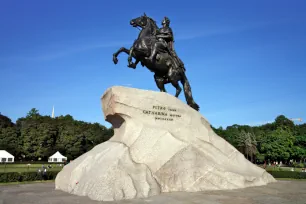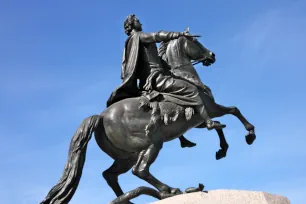The equestrian statue of Peter the Great, known as the Bronze Horseman, is a tribute to the founder of St. Petersburg. The fascinating monument is one of the most famous symbols of the city.

The Statue
The regal statue of Peter the Great sitting astride a great bronze horse was a gift to the city by Catherine the Great to honor her predecessor. The German princess Catherine, who married into the Romanov line, was eager to establish her legitimacy by linking her name to that of the city’s founder, and commissioned French sculptor Etienne-Maurice Falconet with a suiting monument to the founder of the Russian empire.
Falconet built his masterpiece during the years 1768-1782, after long studying the movements of horsemen on reared mounts.
The Design
The imposing statue was the first equestrian statue in St. Petersburg. It depicts the illustrious founder of Saint Petersburg as a determined absolute leader, guiding his country towards the future.


The pedestal of the statue resembles a cliff and is fashioned from one huge, solid piece of red granite. The block of granite alone weighs more than 1600 ton and took nine months to transport from the Gulf of Finland. An inscription on the side of the pedestal says “to Peter the First from Catherine the Second”, on one side in Latin and on the other side in Russian.
Peter and his horse, which is rearing up on its hind legs, sit atop the cliff, facing West and “leading Russia forward”. It is said that the founder faces west because the countries of the West were his source of inspiration for ideas to reform Old Russia. A snake, symbol of treason, is trampled by the horse.
As long as the statue maintains its location in Senatskaya Square, legend says, enemy forces will never overtake St. Petersburg. That legend led government officials to protect the statue during World War II with sandbags and a wooden structure surrounding it. It came through the tumultuous war with barely a scratch.
The Name
The monument was originally known as the Statue of Peter the Great. Its current name stems from a poem by the Russian poet Alexander Pushkin, published in 1833 and named ‘The Bronze Horseman’. In the poem, which was inspired by the great flood of 1824, the statue of Peter I comes to life and pursues the protagonist, Evgeny.

